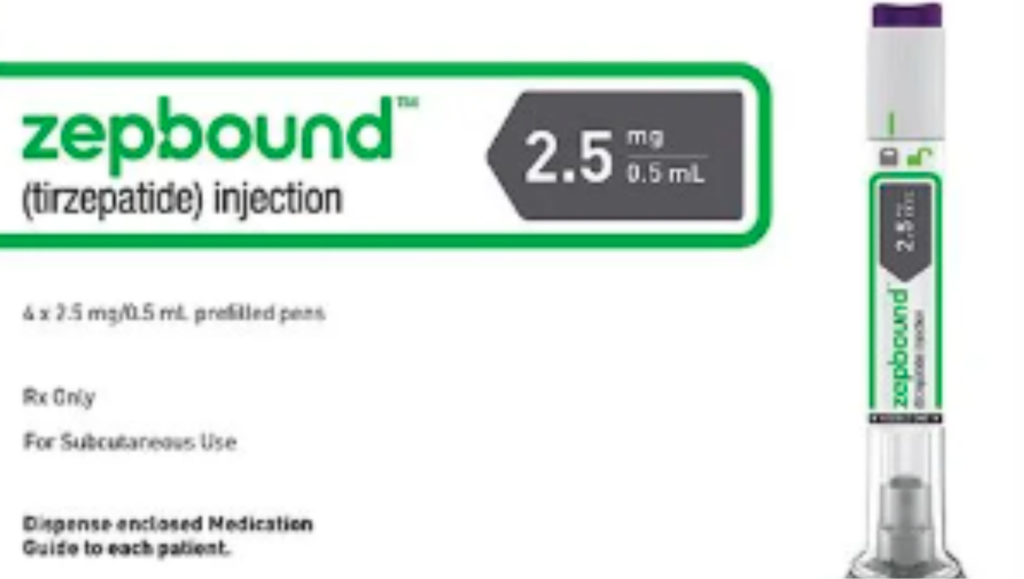Introduction
Zepbound is a new medicine that helps people lose weight. It’s an injection you take once a week, and it’s designed for adults who are overweight or have obesity. The U.S. Food and Drug Administration (FDA) approved it in November 2023, making it one of the latest tools to fight extra weight. Doctors prescribe it to people with a body mass index (BMI) of 30 or higher or those with a BMI of 27 or more who also have health problems like high blood pressure or type 2 diabetes. Zepbound isn’t just a quick fix—it works best when you pair it with healthy eating and exercise.
This medicine has a special ingredient called tripeptide. You might have heard of tripeptide before because it’s also in another drug called Mounjaro, which helps people with diabetes. But Zepbound is explicitly made for weight loss. It’s exciting because it does something different from older weight loss drugs. It copies two natural hormones to help you feel full and manage sugar levels. This dual action makes it a big deal in the world of health.
How Does Zepbound Work?
Zepbound acts like two hormones your body already makes: GLP-1 and GIP. These hormones are like messengers that tell your body what to do after you eat. GLP-1, or glucagon-like peptide-1, helps control your appetite. It talks to your brain and says, “Hey, you’re full—stop eating!” It also slows down how fast food moves through your stomach, so you feel satisfied longer. GIP, or glucose-dependent insulinotropic polypeptide, helps your body use sugar better by boosting insulin, a hormone that keeps blood sugar in check.
When you take Zepbound, it mimics these hormones. It means it tricks your body into thinking it’s had enough food, even if you’ve eaten less than usual. It also helps your insulin work better, which keeps your energy steady. Together, these actions lead to less food intake and better sugar control. Over time, this can help you lose weight and keep it off, mainly if you stick to a healthy lifestyle.
Why Hormones Matter for Weight Loss
Your body uses hormones to manage all sorts of things, like hunger and energy. When these messengers get out of balance, it can be hard to lose weight. For example, if your appetite hormones don’t signal “full” correctly, you might keep eating even when you don’t need to. Or if your insulin isn’t working well, your body might store more fat instead of burning it. It is why Zepbound’s approach is so innovative—it taps into these natural systems.
By copying GLP-1 and GIP, Zepbound fixes some of these problems. It’s not about starving yourself or forcing your body to change. Instead, it works with what’s already there, making minor tweaks that add significant results. It differs from older weight loss methods that try cutting calories without fixing the root issues. With Zepbound, the focus is on balance, which makes weight loss feel more natural and sustainable.

Who Can Use Zepbound?
Not everyone can or should use Zepbound. It’s made for adults who have a lot of extra weight or health issues tied to their weight. If your BMI is 30 or more, you might qualify—this is called obesity. If it’s 27 or higher and you have something like high cholesterol or diabetes, you could also be a candidate. Your doctor will check your health history and measure your BMI to see if it’s right for you.
Kids can’t use Zepbound because it hasn’t been tested enough in younger people. Pregnant women should avoid it, too, since it might harm a baby. If you’re on other medicines, like insulin or birth control pills, you’ll need to talk to your doctor. Zepbound can change how those drugs work so that adjustments might be required. The key is working with a healthcare provider to ensure it’s safe and fits your needs.
How Do You Take Zepbound?
Taking Zepbound is pretty simple. It comes in a pre-filled pen you inject under your skin once a week. You can do it at home, usually in your stomach, thigh, or upper arm. The starting dose is low—2.5 milligrams—to help your body get used to it. After a month, your doctor might bump it to 5 milligrams, then higher if needed, up to 15 milligrams. The goal is to find the best dose without too many side effects.
You don’t need to eat or avoid food when you take it—pick a day of the week and stick to it. Your doctor will show you how to use the pen the first time. It’s quick and not too painful, like a small pinch. However, keeping up with it every week is essential because missing doses might slow down your progress.
What Results Can You Expect?
Zepbound can lead to some impressive weight loss. In studies, people lost between 15% and 26% of their body weight over about a year and a half. That’s a lot—imagine someone who weighs 200 pounds dropping 30 to 50 pounds! The exact amount depends on your starting weight, how much you exercise, and what you eat. People without diabetes tend to lose more than those with it, but everyone sees some benefit.
Weight loss doesn’t happen overnight. You might notice small changes in a few weeks, like feeling less hungry or losing a pound. Over months, it adds up. One study showed that after 72 weeks, people on the highest dose lost about 20% of their weight on average. That’s why patience is key—Zepbound is about steady, long-term progress, not a fast drop.
Why Is It Sustainable?
A lot of diets fail because they’re hard to stick with. You might lose weight fast, but your hunger returns, and the pounds creep up again. Zepbound is different because it tackles appetite at the source. By mimicking hormones that control hunger, it helps you eat less without feeling deprived. It makes it easier to keep up with healthy habits over time.
Plus, it’s not just about weight. Zepbound can improve things like blood sugar and blood pressure, which keep you healthier in the long run. Studies show that people who use it with diet and exercise are more likely to maintain their results. It’s not a magic shot—you still need to make good choices—but it gives you a boost that makes those choices feel doable.
What Are the Side Effects?
Like any medicine, Zepbound has side effects. The most common ones are stomach-related: nausea, diarrhea, vomiting, and constipation. These usually happen when you start or increase your dose, and they often improve over time. Some people also feel tired or get redness when they inject it. Drinking plenty of water and eating small, bland meals can help.
There are rarer, more serious risks, too. Zepbound might cause pancreas problems or kidney issues, especially if you get dehydrated. Animal studies showed a risk of thyroid tumours, but we don’t know if that happens in humans yet. Call your doctor immediately if you notice severe stomach pain, yellow skin, or strange lumps. Most people don’t have big problems, but knowing what to watch for is suitable.

How Does Zepbound Compare to Other Drugs?
You’ve probably heard of drugs like Wegovy or Ozempic. They’re popular for weight loss, too, and they work by copying GLP-1, just like Zepbound. But Zepbound goes a step further by also mimicking GIP. This double action seems to make it more effective. In one study, people on Zepbound lost about 20% of their weight, while those on Wegovy lost around 14%. That’s a noticeable difference.
Cost is another factor. Zepbound’s list price is around $1,000 monthly, but insurance might lower that. Wegovy costs a bit more, and neither is cheap without coverage. Both are injections, but Zepbound’s extra hormone boost might give it an edge for some people. Your doctor can help you pick the best fit for your body and budget.
Can Zepbound Help Beyond Weight Loss?
Yes, Zepbound does more than shrink your waistline. Because it improves insulin sensitivity, it can lower your risk of type 2 diabetes. One study found that people with prediabetes who took it were 94% less likely to get full diabetes after three years. It also helps with things like high cholesterol and blood pressure, which are tied to extra weight.
These bonuses make Zepbound a health game-changer. Losing weight is great, but feeling better overall is even more significant. It’s not approved to treat those conditions alone—if you have diabetes, you will use Mounjaro instead—but the benefits spill over when you use it for weight loss. That’s a win for your whole body.
How to Get Started with Zepbound
If Zepbound might help, start by talking to your doctor. They’ll check your weight, health, and goals to see if they match. You’ll need a prescription, so they’ll write one if it makes sense. Some insurance plans cover it, but you might need to prove it’s medically necessary. Without insurance, it’s pricey, so ask about payment options or discounts from the maker, Eli Lilly.
Once you get it, your doctor will guide you on dosing and lifestyle changes. Pairing Zepbound with a balanced diet—think veggies, lean meats, and whole grains—plus some exercise, like walking or lifting weights, will speed up your results. It’s a team effort between you, your doctor, and the medicine.
Tips for Success with Zepbound
To get the most out of Zepbound, keep it simple. Eat foods that fill you without calories, like salads or grilled chicken. Move your body a little every day— even a 20-minute walk counts. Drink water to avoid side effects like constipation. And stick to your injection schedule—set a phone reminder if needed.
Don’t expect miracles overnight. Track your progress with a notebook or app to stay motivated. If you hit a plateau, talk to your doctor—they might tweak your dose or suggest new habits. The goal is slow, steady wins that last, not a race to the finish line.
What Happens If You Stop?
If you stop taking Zepbound, the effects might fade. Your appetite and some weight might return, especially if you don’t keep up with diet and exercise. In one study, people who quit after a year gained back some pounds, though not all. It shows it’s a long-term tool—stopping doesn’t erase what you’ve learned, but it takes away the hormone help.
Talk to your doctor before quitting. They can help you ease off or switch to another plan. The key is to build habits that stick so you’re not relying on the shot forever. It’s about finding a balance that works for you.
Is Zepbound Right for You?
Deciding on Zepbound depends on your situation. If you’ve tried diets and workouts without luck and your weight is hurting your health, it could be worth a shot. It’s not for everyone—side effects or cost might rule it out. But for many, it’s a fresh start that makes weight loss feel possible.
Think about your goals. Want to feel better, fit into old clothes, or dodge diabetes? Zepbound might help. Chat with your doctor, weigh the pros and cons, and see if it fits your life. It’s not a cure-all but a powerful helper for the right person.
The Future of Weight Loss with Zepbound
Zepbound is part of a new wave of weight loss tools. Scientists are excited because it shows how hormones can unlock better health. More studies are coming to see how long the benefits last and who it helps most. It’s not the end of the story—just a big step forward.
For now, it’s changing lives. People are losing weight, feeling more assertive, and dodging health problems. It’s proof that working with your body, not against it, is the way to go. Whether you try it or not, Zepbound is a sign that weight loss is getting more thoughtful and personal.
References
- U.S. Food and Drug Administration (FDA). “FDA Approves New Medication for Chronic Weight Management.” November 8, 2023.
- Eli Lilly and Company. “Zepbound (tirzepatide) Prescribing Information.” 2023.
- Jastreboff, A. M., et al. “Tirzepatide Once Weekly for the Treatment of Obesity.” New England Journal of Medicine, 2022.
- WebMD. “How Zepbound Works for Weight Loss.” July 22, 2024.
- American Diabetes Association. “Incretin Hormones and Weight Management.” 2023.
- Healthline. “Zepbound for Weight Loss: Health Experts Answer 10 Common Questions.” December 8, 2023.





